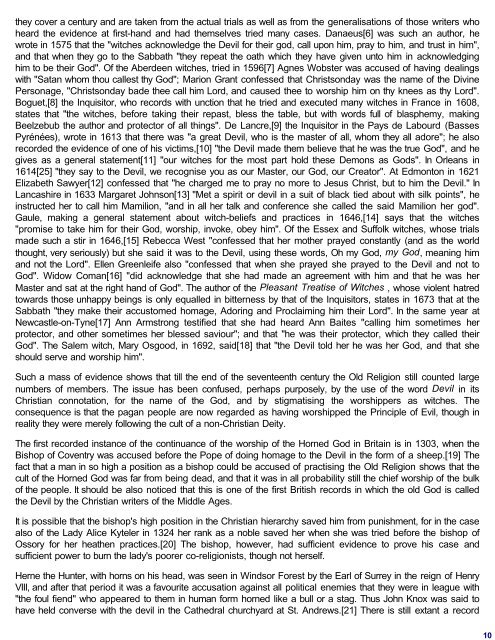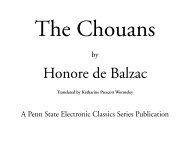THE GOD OF THE WITCHES - World eBook Library - World Public ...
THE GOD OF THE WITCHES - World eBook Library - World Public ...
THE GOD OF THE WITCHES - World eBook Library - World Public ...
Create successful ePaper yourself
Turn your PDF publications into a flip-book with our unique Google optimized e-Paper software.
they cover a century and are taken from the actual trials as well as from the generalisations of those writers who<br />
heard the evidence at first-hand and had themselves tried many cases. Danaeus[6] was such an author, he<br />
wrote in 1575 that the "witches acknowledge the Devil for their god, call upon him, pray to him, and trust in him",<br />
and that when they go to the Sabbath "they repeat the oath which they have given unto him in acknowledging<br />
him to be their God". Of the Aberdeen witches, tried in 1596[7] Agnes Wobster was accused of having dealings<br />
with "Satan whom thou callest thy God"; Marion Grant confessed that Christsonday was the name of the Divine<br />
Personage, "Christsonday bade thee call him Lord, and caused thee to worship him on thy knees as thy Lord".<br />
Boguet,[8] the Inquisitor, who records with unction that he tried and executed many witches in France in 1608,<br />
states that "the witches, before taking their repast, bless the table, but with words full of blasphemy, making<br />
Beelzebub the author and protector of all things". De Lancre,[9] the Inquisitor in the Pays de Labourd (Basses<br />
Pyrénées), wrote in 1613 that there was "a great Devil, who is the master of all, whom they all adore"; he also<br />
recorded the evidence of one of his victims,[10] "the Devil made them believe that he was the true God", and he<br />
gives as a general statement[11] "our witches for the most part hold these Demons as Gods". In Orleans in<br />
1614[25] "they say to the Devil, we recognise you as our Master, our God, our Creator". At Edmonton in 1621<br />
Elizabeth Sawyer[12] confessed that "he charged me to pray no more to Jesus Christ, but to him the Devil." In<br />
Lancashire in 1633 Margaret Johnson[13] "Met a spirit or devil in a suit of black tied about with silk points", he<br />
instructed her to call him Mamilion, "and in all her talk and conference she called the said Mamilion her god".<br />
Gaule, making a general statement about witch-beliefs and practices in 1646,[14] says that the witches<br />
"promise to take him for their God, worship, invoke, obey him". Of the Essex and Suffolk witches, whose trials<br />
made such a stir in 1646,[15] Rebecca West "confessed that her mother prayed constantly (and as the world<br />
thought, very seriously) but she said it was to the Devil, using these words, Oh my God, my God, meaning him<br />
and not the Lord". Ellen Greenleife also "confessed that when she prayed she prayed to the Devil and not to<br />
God". Widow Coman[16] "did acknowledge that she had made an agreement with him and that he was her<br />
Master and sat at the right hand of God". The author of the Pleasant Treatise of Witches , whose violent hatred<br />
towards those unhappy beings is only equalled in bitterness by that of the Inquisitors, states in 1673 that at the<br />
Sabbath "they make their accustomed homage, Adoring and Proclaiming him their Lord". In the same year at<br />
Newcastle-on-Tyne[17] Ann Armstrong testified that she had heard Ann Baites "calling him sometimes her<br />
protector, and other sometimes her blessed saviour"; and that "he was their protector, which they called their<br />
God". The Salem witch, Mary Osgood, in 1692, said[18] that "the Devil told her he was her God, and that she<br />
should serve and worship him".<br />
Such a mass of evidence shows that till the end of the seventeenth century the Old Religion still counted large<br />
numbers of members. The issue has been confused, perhaps purposely, by the use of the word Devil in its<br />
Christian connotation, for the name of the God, and by stigmatising the worshippers as witches. The<br />
consequence is that the pagan people are now regarded as having worshipped the Principle of Evil, though in<br />
reality they were merely following the cult of a non-Christian Deity.<br />
The first recorded instance of the continuance of the worship of the Horned God in Britain is in 1303, when the<br />
Bishop of Coventry was accused before the Pope of doing homage to the Devil in the form of a sheep.[19] The<br />
fact that a man in so high a position as a bishop could be accused of practising the Old Religion shows that the<br />
cult of the Horned God was far from being dead, and that it was in all probability still the chief worship of the bulk<br />
of the people. It should be also noticed that this is one of the first British records in which the old God is called<br />
the Devil by the Christian writers of the Middle Ages.<br />
It is possible that the bishop's high position in the Christian hierarchy saved him from punishment, for in the case<br />
also of the Lady Alice Kyteler in 1324 her rank as a noble saved her when she was tried before the bishop of<br />
Ossory for her heathen practices.[20] The bishop, however, had sufficient evidence to prove his case and<br />
sufficient power to burn the lady's poorer co-religionists, though not herself.<br />
Herne the Hunter, with horns on his head, was seen in Windsor Forest by the Earl of Surrey in the reign of Henry<br />
VIII, and after that period it was a favourite accusation against all political enemies that they were in league with<br />
"the foul fiend" who appeared to them in human form horned like a bull or a stag. Thus John Knox was said to<br />
have held converse with the devil in the Cathedral churchyard at St. Andrews.[21] There is still extant a record<br />
10















